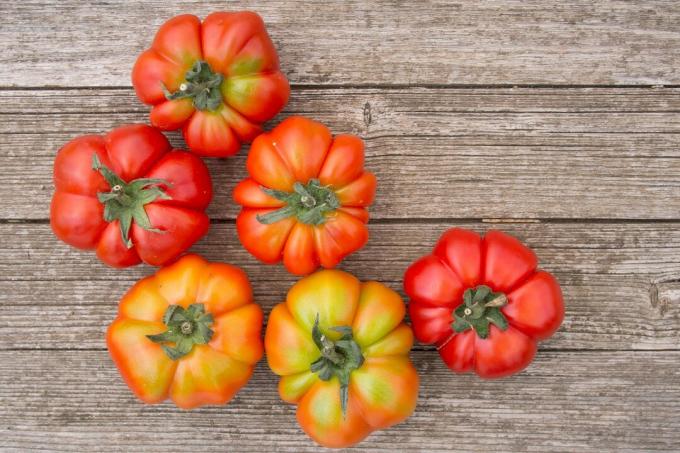The tomato variety 'Costoluto Genovese' convinces with its large fruits in an unusual shape. Here you can find out what you should consider when growing and caring for Costoluto tomatoes.

The 'Costoluto Genovese' tomato is reminiscent of summer holidays in Italy, of sun-warmed, large red beefsteak tomatoes and their fruity taste. We present the classic 'Costoluto Genovese' in this profile and give tips for cultivation in our latitudes.
contents
- Costoluto Genovese: Wanted Poster
- Origin and history of the tomato
- Taste & properties of the beefsteak tomato Costoluto Genovese
- Tips on growing and caring for Costoluto Genovese
- Harvesting and using costoluto tomatoes
Costoluto Genovese: Wanted Poster
| fruit | beef tomato; Red |
| the taste | fruity, mild, slightly sour |
| maturing time | late |
| growth | Stick tomato, up to 180 cm |
| location | Greenhouse, sheltered field, tub |
Origin and history of the tomato
The large-fruited 'Costoluto Genovese', which translates as 'Genoa ribs', comes from Piedmont, north-west of Genoa. She was probably already 18. Known for centuries and has been preserved in the gardens to this day. In Italy there are other ribbed beefsteak tomatoes that are named after their region of origin, such as 'Costoluto Fiorentino' or 'Costoluto Cantanese'.
Taste & properties of the beefsteak tomato Costoluto Genovese
With an average weight of around 200 grams, the bright red tomato variety 'Costoluto Genovese' is one of the smaller beefsteak tomatoes. Your plants usually grow to about 180 centimeters in height. The fruits are often heavily ribbed and ripen in clusters of four to six tomatoes from the end of August until the end of the season. The yield of this beefsteak tomato is high and reliable. The taste of the 'Costoluto Genovese' tomato is fruity, slightly sour and mildly sweet. The historic variety is seedfast, so you can easily Get tomato seeds yourself and sow the 'Costoluto Genovese' again the next year.

Tips on growing and caring for Costoluto Genovese
'Costoluto Genovese' is quite robust and not very susceptible to disease. It is suitable for cultivation in tubs, in greenhouses and in protected outdoor areas. The tomato variety that needs warmth benefits particularly from a warm house wall and rain protection. From the beginning of May, plant the 'Costoluto Genovese' in the greenhouse, from mid-May after the ice saints in pots or outdoors. When planting, fill the planting hole with a special substrate like ours Plantura organic tomato & vegetable soil, and put the young plants into it. The high compost content and the nutrients already contained supply the 'Costoluto Genovese' until the first fertilization and promote root growth. After planting, support the 'Costoluto Genovese' with a stake and tie loosely.
The 'Costoluto Genovese' is easy to care for and can easily be grown with two shoots. For this you need all side shoots of the tomato, except for a deep-seated drive. This is pulled up as the second shoot, is best given its own support and is connected separately. Clusters of flowers and other fruits soon form on this shoot. From June it will be time for the first fertilization, because tomatoes, as heavy consumers, need a particularly large number of nutrients in order to produce a rich yield. You can do this with an organic liquid fertiliser, such as our Plantura organic tomato & vegetable fertiliser Fertilize tomatoes very effortlessly. The plant-based NK fertilizer is added to the irrigation water about once a week.
Harvesting and using costoluto tomatoes
The large beefsteak tomato 'Costoluto Genovese' is ideal when sliced for on bread or in a salad. The large fruits are productive and tasty in soups and sauces, they are generally good for processing.
The ox heart tomato also reminds us of summer days and colorful farmers markets in France and Italy. We provide you with these specially shaped tomatoes and the best varieties in our article Oxheart tomato and provide tips on cultivation and use.



